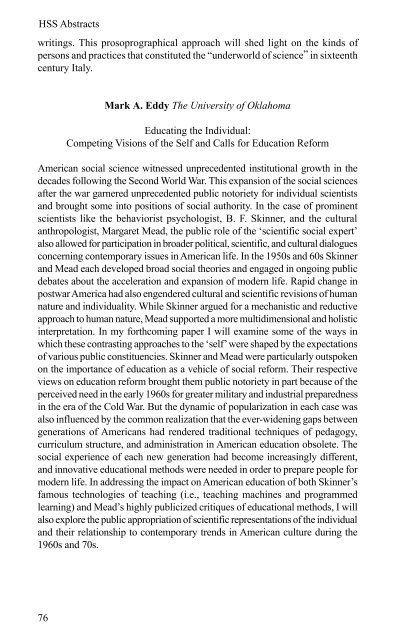2000 HSS/PSA Program 1 - History of Science Society
2000 HSS/PSA Program 1 - History of Science Society
2000 HSS/PSA Program 1 - History of Science Society
Create successful ePaper yourself
Turn your PDF publications into a flip-book with our unique Google optimized e-Paper software.
<strong>HSS</strong> Abstracts<br />
writings. This prosoprographical approach will shed light on the kinds <strong>of</strong><br />
persons and practices that constituted the “underworld <strong>of</strong> science” in sixteenth<br />
century Italy.<br />
Mark␣ A. Eddy The University <strong>of</strong> Oklahoma<br />
Educating the Individual:<br />
Competing Visions <strong>of</strong> the Self and Calls for Education Reform<br />
American social science witnessed unprecedented institutional growth in the<br />
decades following the Second World War. This expansion <strong>of</strong> the social sciences<br />
after the war garnered unprecedented public notoriety for individual scientists<br />
and brought some into positions <strong>of</strong> social authority. In the case <strong>of</strong> prominent<br />
scientists like the behaviorist psychologist, B. F. Skinner, and the cultural<br />
anthropologist, Margaret Mead, the public role <strong>of</strong> the ‘scientific social expert’<br />
also allowed for participation in broader political, scientific, and cultural dialogues<br />
concerning contemporary issues in American life. In the 1950s and 60s Skinner<br />
and Mead each developed broad social theories and engaged in ongoing public<br />
debates about the acceleration and expansion <strong>of</strong> modern life. Rapid change in<br />
postwar America had also engendered cultural and scientific revisions <strong>of</strong> human<br />
nature and individuality. While Skinner argued for a mechanistic and reductive<br />
approach to human nature, Mead supported a more multidimensional and holistic<br />
interpretation. In my forthcoming paper I will examine some <strong>of</strong> the ways in<br />
which these contrasting approaches to the ‘self’ were shaped by the expectations<br />
<strong>of</strong> various public constituencies. Skinner and Mead were particularly outspoken<br />
on the importance <strong>of</strong> education as a vehicle <strong>of</strong> social reform. Their respective<br />
views on education reform brought them public notoriety in part because <strong>of</strong> the<br />
perceived need in the early 1960s for greater military and industrial preparedness<br />
in the era <strong>of</strong> the Cold War. But the dynamic <strong>of</strong> popularization in each case was<br />
also influenced by the common realization that the ever-widening gaps between<br />
generations <strong>of</strong> Americans had rendered traditional techniques <strong>of</strong> pedagogy,<br />
curriculum structure, and administration in American education obsolete. The<br />
social experience <strong>of</strong> each new generation had become increasingly different,<br />
and innovative educational methods were needed in order to prepare people for<br />
modern life. In addressing the impact on American education <strong>of</strong> both Skinner’s<br />
famous technologies <strong>of</strong> teaching (i.e., teaching machines and programmed<br />
learning) and Mead’s highly publicized critiques <strong>of</strong> educational methods, I will<br />
also explore the public appropriation <strong>of</strong> scientific representations <strong>of</strong> the individual<br />
and their relationship to contemporary trends in American culture during the<br />
1960s and 70s.<br />
76
















